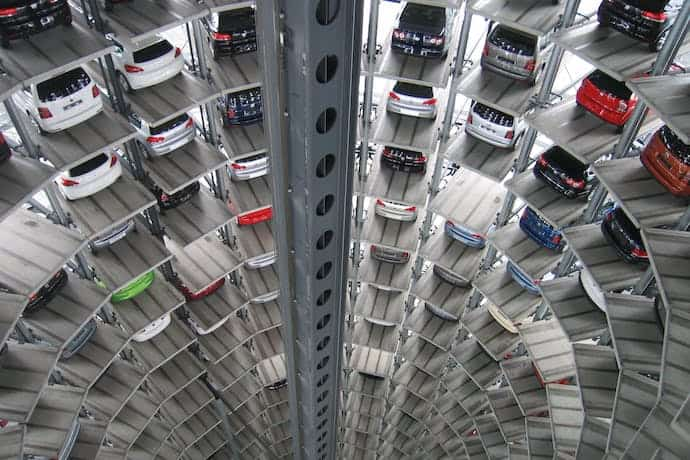Smart Parking: Using Data to Meet the Challenge of City Parking

Cities and the private sector are working on solutions to the problem that address both how we find and pay for parking.
If you’re like me, you probably remember sitting in the back seat of the family car as a child, searching for parking. I remember especially the summer days: the sweat pooling on my back and the smell of baking asphalt, as I shifted to avoid the sun’s rays through the windows.
What I didn’t know then was that this hunt for parking was not just a personal discomfort (albeit with a taste of triumph at the end), but a detriment to society. Inrix calculated that the average American spent about $1400 on just the indirect costs of parking in 2017—the fuel and time wasted looking for a spot. Of course, those circling miles also contribute to climate change. Donald Shoup, the leading expert in demand-based parking, calculated that in a 15 block area in Los Angeles alone, circling produced 730 tons of CO2 in a year.
The good news is cities and the private sector are working on solutions to the problem that address both how we find and pay for parking.
Reinventing How We Find and Pay for Parking
In Lille, France, for example, the metropolis partnered with Opendatasoft to aggregate and share data from Waze, bikeshare operators, and transit—data that an entrepreneur then used to create a free real-time parking availability app. Another Opendatasoft client, Saemes, the second largest parking provider in the Paris region, has an open data portal dedicated to parking data. This portal is enabling solutions to finding parking, including accessible.net, which is specifically for finding spots accessible to people with disabilities.
In San Francisco, meanwhile, the Municipal Transportation Agency (MTA) has moved this year to demand-responsive pricing for the 28,000 spaces it manages after a successful pilot which saw average meter rates fall by 4% and time spent looking for a spot fall by 30 percentage points over control areas. Demand-responsive pricing is one of Shoup’s most vehement recommendations, but in past decades it has been beyond the reach of cities. Now, using networked meters, San Francisco and a few other cities determine block by block, lot by lot, how heavy demand is for parking and charges accordingly.
Of course, when one thinks of giving all those circling cars a place to land, demand-responsive pricing is only one prong—drivers need to know where the open spots are in order to take advantage of them.
A Predictive Algorithm to Determine Parking Price
In San Francisco’s pilot stage, which involved 7,000 spaces, the city installed sensors that provided real-time availability information. This information was available to drivers through the MTA’s own app, and to other app developers. The sensors were expensive, however, and when the MTA expanded the program city-wide, they did not replace them or install new sensors. Instead, they relied on the data collected during the pilot to create an algorithm that predicts parking availability based on revenues collected in the previous hours. That predicted availability then determines the price. Pricing data is still open to developers and so ultimately to the public as a proxy for open spots, according to Hank Wilson, SFMTA’s parking policy manager. “We expect a lot of the same benefits [as in the pilot],” Wilson said. “If you give them the right price, people will figure it out.”
I spoke to David Eaves, Lecturer in Public Policy at the Harvard Kennedy School of Government and digital government entrepreneur, about the issue of parking. When it came to using such a predictive algorithm, he was largely supportive. “I actually think that’s good—it may be marginally less accurate than sensors but those in-ground sensors are very expensive,” he said. “My sense is that the weakness is that it will not handle outlier events very well.”
He also didn’t think drivers would miss the real-time availability information very much. “It’s not that valuable being able to open an app and see exactly where the spots are; parking is so liquid that even in the time it takes you to get to a spot it may no longer be available.” (I asked Wilson if SFMTA had collected data on just that—how often, when an app directed a driver to a spot it was still available when they arrived—and he said they had not).
San Francisco’s program is so new city-wide that it will be some time before the effects are known. But Eaves raised a couple of broader concerns.
Big Picture: Mobility and Interconnectivity
First, there is the fact that cities are pursuing solutions to parking from siloed positions, leading to inefficient redundancies for drivers whose daily commute does not respect municipal boundaries. “Why do I need three different payment apps for Cambridge, Boston and Somerville [Passport Park, Park-Boston, and ParkMobile, respectively]?” Eaves asked rhetorically. More than that, there’s the question of what happens to the data private companies collect when they are responsible for metering. Eaves pointed out that most cities have rules about what they themselves can do with this data, but when they outsource meter management, many do not apply the same rules to the private vendor. One solution is to require meter vendors to use open APIs that allow drivers to use any app to pay for parking.
The second complication is the looming rise of autonomous vehicles and the fact that parking may become less important in the future while pick-up and drop-off space becomes more important. This possibility is still remote enough that Wilson said it did not affect the investment decision in smart parking. Moreover, much of the same economics will apply to Transportation Network Companies (TNCs) like Uber and Lyft. “I think demand-responsive-pricing [for parking] can serve as a model for how we value curb-space for TNCs,” Wilson said.
Eaves agreed. “It is clear that pricing AV pick up more accurately is very important,” he said, before going on to explain his skepticism about the ultimate utility of any solution that stays within the auto-dominant model of transport. “The question I would ask a city is—if you had 30 million to spend on overall goals for making your city more walkable and livable—is this what you’d spend it on?”
(That 30 million figure is hypothetical, but perhaps not that far off. Wilson told me installing all the meters for the new parking program cost 11 million, though the current meters were reaching the end of their useful life and would have needed to be replaced anyway, while the database and analytics software cost “a few million” more—and that doesn’t factor in staff time or opportunity cost).
Smart parking will not be the sole answer to cities’ transportation problems. However, for many cities, it will be an essential component of a multi-modal solution, and it will certainly relieve a daily annoyance for many who work and live in them. As cities implement smart solutions to individual components of their transportation systems, it will be increasingly important to incorporate data sharing systems behind the scenes to integrate otherwise separate data sources and applications. An integrated approach will lead to new solutions for drivers—for example, parking operators are already thinking about partnering with third parties to guide drivers to lots with available spaces—but these solutions depend on a data infrastructure that can share different types of information and signals in real time.
The Alliance for Parking Data Standards (APDS), recently formed by the International Parking Institute (IPI), the British Parking Association (BPA), and the European Parking Association (EPA) enacts this integrated approach at the international level. The APDS mission is in fact to develop, promote, manage, and maintain a uniform global standard that will allow organizations to share parking data across platforms worldwide.
In the meantime, fewer sweaty t-shirts and more time at work and play is an equation I suspect most of us can get behind.

In today’s digital-first world, data sharing and use is essential to effective local government operations. Based on our recent webinar, Opendatasoft customers the City of Kingston and the Town of Cary explain how data portals are helping them to deliver on the needs of their citizens and employees.

Across the globe cities and municipalities are transforming themselves into smart cities, improving the urban environment for citizens, visitors, and businesses, while boosting efficiency and sustainability. In this blog we explain what a smart city is and how to build one successfully.

In a changing world, cities and municipalities need to provide seamless access to reliable, high-quality data to all employees if they are to meet their objectives around efficiency, improving the lives of residents, innovation and sustainability. We explain the importance of internal data portals to delivering on these needs.
